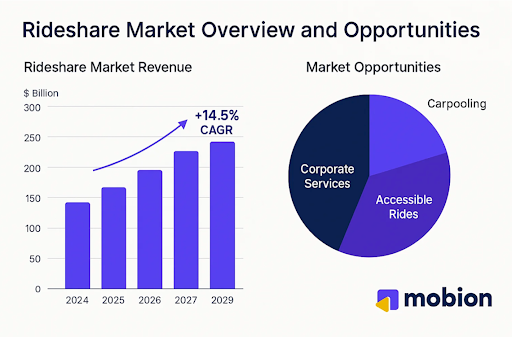How to Start a Ride Share Business


Thinking about starting a ride share business? Start small and local. Picture a mid size city, three reliable drivers, and clear hours for airport runs and late night pickups. People are already looking for simple, safe rides that don’t cost a fortune. That demand won’t fade soon, and it leaves space for new services that treat riders well.
Getting from idea to first booking takes a few practical moves. Check your local rules for TNC licensing. Set basic insurance, background checks, and a clean onboarding flow. Choose one niche to begin with, then price it clearly. And use tech that just works, because riders judge you on the app, not the promise.
You don’t need to code anything. The MobiOn platform gives you booking, driver and vehicle management, GPS tracking, and payments out of the box. With that handled, you can spend your week on growth work, like recruiting drivers, meeting partners, and answering riders fast when they need help.
This guide shows the exact steps to launch with confidence. We’ll cover planning, legal setup, software, and early marketing, then move into operations and scale. Follow along, apply each step, and turn your first ten rides into a steady stream.
What Is Rideshare and How It Works
Ever been stuck waiting for a bus that never shows? Or tried to wave down a cab in the rain? That’s exactly the problem ridesharing solves. You open an app, tap where you are and where you want to go, and a driver nearby heads your way. Simple.
So, how does ride share work once you hit that confirm button? The app checks which drivers are free and closest, then sends your request. A driver accepts, you see their car moving on the map, and within minutes you’re on the road. At the end, the payment happens inside the app. No cash, no awkward talk about change.
For drivers, it’s a side job they can turn on or off. For riders, it’s peace of mind - you know the cost up front and you can track the trip. And for the company running it, growth means bringing in more drivers and covering new neighborhoods.
In the end, ridesharing isn’t some fancy idea. It’s just people helping people get around, powered by a bit of smart software. That’s why it feels natural now, like grabbing coffee on the go.
Rideshare Market Overview and Opportunities
The rideshare business has grown fast and it’s still picking up speed. Just look at the chart. Each year the bars rise higher, and the line points to even more growth ahead. Around 14 percent yearly gains may not sound huge at first, but in transport that’s a lot.

What does this growth actually mean? It shows that there’s plenty of room for new ideas. Companies are already trying different approaches. Some focus on corporate travel, where businesses cover rides for their staff instead of buying cars. Others go for carpooling, letting people share trips and cut costs. There’s also a clear need for accessible rides that support seniors and passengers with mobility challenges.
The interesting part is that you don’t need to chase the whole market. Success often comes from spotting one gap and serving it better than anyone else. Maybe it’s commuters in a busy area, maybe late-night workers, maybe families. The opportunity is in choosing a niche and building trust around it. Growth will follow.
Research, Niche Selection, and Target Audience
Good research sets the tone for everything that follows. Walk around your city and watch how people move. Do buses leave riders behind? Do taxis overcharge at night? Maybe a whole district has no easy way to reach downtown. Noticing these things gives you ideas on where to step in.
Picking a niche is where the real focus starts. You don’t need to serve the whole city. Think of one case. A group of workers finishing shifts at 2 a.m. with no buses running. Or a student who just wants a cheaper way to get across town. Or a parent booking a ride so their kid gets home safely after practice. These everyday stories tell you more than any spreadsheet.
So ask yourself: who do you want to help first? A ridesharing company that solves one problem well usually gets noticed faster than another generic service.
Begin small and keep close to your riders. Talk to them, hear what feels good and what doesn’t. Fix the weak spots, repeat what works. Once one group trusts you, it becomes easier to reach the next. Growth built this way tends to stick.
Building a Unique Value Proposition and Brand
Imagine two apps on your phone. Both can get you from A to B. Why would you open one and not the other? That answer is what makes a service stand out.
Sometimes the difference is price. A few dollars less on a daily trip adds up fast. Sometimes it’s safety - parents want child seats, or young riders want to know the driver is verified. Other times it’s comfort, like cleaner cars or drivers who actually know the shortcuts.
Pick one thing and make it yours. If you try to promise everything, people won’t believe it. But if you deliver one clear benefit again and again, riders remember.
Branding is how you tell that story. A name people can say easily. Colors and symbols they notice in the app or on the car door. Even the tone of your messages matters - friendly, serious, playful, it all shapes how people feel.
For a ride sharing company, brand is not decoration. It’s the first impression before the trip, and the reason someone comes back after. Nail that, and you don’t just get riders, you get regulars.
Business Planning and Legal Requirements
Every new service needs a plan. Start with the basics, no fancy slides.
Step 1. Write it down. What kind of trips will you offer, airport runs, late-night rides, or daily commutes? How many drivers can you realistically bring in at the start? What money do you have to cover the first few months? Put the numbers on paper, even if they are rough.
Step 2. Check the rules. Laws change from city to city. Some require a transport permit, others focus on insurance. Ignore this and your launch can end before the first ride.
Step 3. Cover safety. Most regions ask for driver background checks and vehicle inspections. It takes time, but it builds trust. Riders feel safer, and drivers know they are protected.
Picture yourself at the local office, waiting with forms in hand. It may feel slow, but each stamp moves you closer to operating legally.
Plenty of guides explain how to start a rideshare company in long and complex ways. In reality, it comes down to small steps. Write a plan you understand, confirm the paperwork with your authority, and keep ticking items off. That is how an idea turns into a working service.
Technology and App Development
So, what is a rideshare app really? It’s the thing that makes the whole idea possible. Without it, riders are just waiting on the curb and drivers are just driving around empty. The app is the middle point, showing who needs a ride, who’s nearby, and how to connect the two.
From a rider’s view it looks almost too easy. Open the app, type the address, see the price, and watch the little car icon crawl closer on the map. Rain or shine, you know help is coming. For drivers, it’s just as clear. A ping lights up the phone, they accept, follow the GPS, and get paid without carrying cash.
Now, how do you build something that smooth? Many founders ask how to create a rideshare app without wasting months. One way is to hire a dev team and start from zero, but that’s costly and slow. The other way is to start with a ready platform, customize it to your brand, and launch sooner.
At the end of the day, riders and drivers don’t care how clever the code is. They care that it works. If the app is fast, simple, and trustworthy, people will come back. If it’s clunky, they won’t. It’s really that simple.
Recruiting Drivers and Managing Fleet
Picture this. A driver walks in with a folder of papers — license, insurance, a copy of registration. He wants to earn extra money, but he also wants the process to be simple. If it takes weeks, he will give up. If it takes days, he is ready to hit the road.
Recruiting drivers is the heart of a ride share business. Start local. A quick post online, a chat at a gas station, or a flyer at the airport can bring in your first applicants. Make sign-up easy to follow. Yes, you need background checks and insurance details, but guide drivers step by step so they don’t feel stuck.
Fleet management is not about owning dozens of cars. Most drivers use their own vehicles. What matters is quality. Riders notice dirty seats, broken seatbelts, or warning lights. Set simple rules and encourage regular checks. Even small standards make a big difference in trust.
And don’t forget, drivers are people, not just profiles in an app. Pay them when you say you will. Pick up the phone when they call. Respect goes a long way, and respected drivers usually become the ones who stay the longest.
Pricing, Marketing, and Launch Strategy
Pricing is often the first thing riders notice. Set it too high and they stick with taxis. Set it too low and you burn cash. The trick is balance. Look at local fares, then decide where you can compete. Maybe you undercut slightly at launch to win attention. Or maybe you charge the same but offer something extra, like shorter wait times or cleaner cars.
Marketing is where you start telling your story. Flyers at busy spots, social media ads, and word of mouth all work, especially at the beginning. Riders trust what friends say more than what ads promise. Think about small gestures too: the first ride free, referral discounts, or promo codes for students. These cost little but bring in early users.
A launch should feel like an event, not a soft opening. Pick a neighborhood, recruit enough drivers to cover it well, and then go live. Make sure people see the cars, notice the logo, and hear about the service. Even small local press coverage or a partnership with a business district can spark curiosity.
For a new ride share company, the launch is not just day one - it is the moment people decide if you are worth trying again. If the app works, rides are affordable, and the service feels reliable, your first customers become repeat customers. From there, growth comes one trip at a time.
Challenges and How to Overcome Them
Running a ride sharing business is not smooth every day. Problems show up, and they feel real fast.
Imagine this. It is Friday night, riders are waiting, but there are not enough drivers online. Wait times jump, people get annoyed. The fix is simple in theory: recruit more, pay on time, and offer peak bonuses. Drivers need reasons to log in when demand is high.
Another scene. A rider taps the app, the screen freezes, payment fails. In seconds, trust is gone. Tech slips like this happen, but the response matters. Quick updates, honest support, and fast fixes keep people from deleting the app.
Competition is always there too. Big brands own the billboards. Instead of copying them, carve out a space. Maybe focus on safe late-night rides or reliable airport trips. Small groups that trust you are worth more than chasing everyone at once.
And don’t forget the rules. Cities change laws without warning. Stay alert, keep in touch with regulators, and adjust before trouble hits.
Challenges never stop, but each one you solve makes the service stronger, and your riders more loyal.
The Future of Rideshare
The way people move is still changing. Ten years ago most riders waved for a taxi. Now they tap a screen. In another ten years, it will look different again.
Electric cars are showing up more and more. Drivers like them because fuel is cheaper. Riders like them because they feel cleaner and quieter. Cities are adding charging stations on every corner, which means EV fleets are realistic now, not just an idea.
Self-driving cars are being tested too. They are not ready for daily use everywhere, but the trend is clear. Riders may soon get used to trips where no driver is behind the wheel.
At the same time, new niches are opening. Parents want safer rides for kids. Seniors want easier access. Businesses want control and tracking. Many are turning to corporate ride sharing software instead of keeping company cars. It is cheaper, less hassle, and works with a few clicks.
The future will not be one big change. It will be many small shifts. Cleaner cars, smarter apps, more choice. The services that listen to what riders need and adapt fast will be the ones still growing in the years ahead.
Final Thoughts on Starting a Rideshare Service
Starting a rideshare service can feel big. But it starts small. One town. A few drivers. Riders who just need a safe ride. That is enough.
Talk to people first. Ask drivers what makes them stay. Ask riders what they do not like in other apps. Write it down. Try one fix at a time.
Things will break. A trip gets canceled. A driver leaves. The app stops working for a day. It happens. Fix what you can and keep moving.
Growth comes from trust. Riders come back when trips are safe. Drivers stay when pay is fair. Trust takes time. But once it is there, it sticks.
So do not wait for a perfect launch. Start with one small step. Test it. See how it works. And if you want help with the tech, or just an honest talk, reach out to us. We can share what has worked and guide you forward.
F.A.Q.
Ready to revolutionize your taxi business?
Choose what you need: